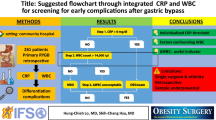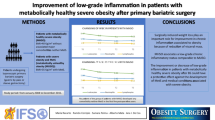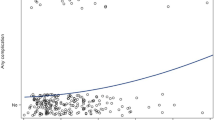Abstract
Background
Obesity has been widely recognized as a chronic inflammatory condition and associated with elevated inflammatory indicators including C-reactive protein (CRP) and white blood cell count (WBC). Recent studies have shown elevated CRP or WBC is a significant risk factor for cardiac events and stroke but the clinical significance of CRP and WBC has not been clearly studied in morbidly obese patients. This study is aimed at the clinical significance of WBC and CRP in morbidly obese patients and the change after bariatric surgery.
Methods
The study was a prospectively controlled clinical study. From December 1, 2001 to January 31, 2006, of 640 (442 females and 198 males) consecutive morbid obese patients enrolled in a surgically supervised weight loss program with at least 1 year’s follow-up were examined.
Results
Of the patients, 476 (74.4%) had elevated CRP and 100 (15.6%) had elevated WBC at preoperative study. CRP and WBC were significantly related and both increased with increasing body mass index (BMI). CRP is also increased with increasing waist, glucose level, hemoglobin, albumin, Ca, insulin, C-peptide, and metabolic syndrome while WBC is increased with metabolic syndrome but decreased with increasing age. Multivariate analysis confirmed fasting glucose level and hemoglobin are independent predictors of the elevation of CRP while age is the only independent predictor for elevated WBC. Both WBC and CRP levels decreased rapidly after obesity surgery. These improvements resulted in a 69.8% reduction of CRP and 26.4% reduction of WBC 1 year after surgery. Although individuals who underwent laparoscopic gastric bypass lost significantly more weight (36.8 ± 11.7 kg vs. 17.3 ± 10.8 kg; p = 0.000) and achieved a lower BMI (27.8 ± 4.6 vs. 35.0 ± 5.5; p = 0.000) than individuals who underwent laparoscopic gastric banding, there was no difference in the resolution of elevated CRP 1 year after surgery (95.9% vs. 84.5%; p = 0.169) and WBC (99.4% vs. 98.3%; p = 0.323).
Conclusions
Both baseline WBC and CRP are elevated in morbid obese patients but CRP has a better clinical significance. Significant weight reduction 1 year after surgery markedly reduced CRP and WBC with a resolution rate of 93.9% and 98.2% separately. Obesity surgery performed by laparoscopic surgery is recommended for obese patients with elevated CRP or WBC.





Similar content being viewed by others
References
Mokdad AH, Ford ES, Bowman BA, et al. Prevalence of obesity, diabetes, and obesity-related health risk factors, 2001. JAMA. 2003;289:76–9.
Dietel M. Overweight and obesity worldwide now estimated to involve 1.7 billion people (Editorial). Obes Surg. 2003;13:329–30.
Lee YH, Pratley RE. The evolving role of inflammation in obesity and the metabolic syndrome. Curr Diab Rep. 2005;5:70–5.
Wisse BE. The inflammatory syndrome: the role of adipose tissue cytokines in metabolic disorders linked to obesity. J Am Soc Nephrol. 2004;15:2792–800.
Fisch IR, Freedman SH. Smoking, oral contraceptives, and obesity. Effects on white blood cell count. JAMA. 1975;234:500–6.
Visser M, Bouter LM, McQuillan GM, et al. Elevated C-reactive protein levels in overweight and obese adults. JAMA. 1999;282:2131–5.
Lemieux I, Pascot A, Prud’homme D, et al. Elevated C-reactive protein: another component of the atherothrombotic profile of abdominal obesity. J Am Heart Assoc. 2001;21:961–7.
Yarnell JW, Baker IA, Sweetnam PM, et al. Fibronogen, viscosity, and white blood cell count are major risk factors for ischemic heart disease. The Caephilly and Speedwell collaborative heart disease studies. Circulation. 1991;83:836–44.
Hansen LK, Grimm RH Jr, Neaton JD. The relationship of white blood cell count to other cardiovascular risk factors. Int J Epidemiol. 1990;19:881–8.
Mendall MA, Strchan DP, Butland BK, et al. C-reactive protein: relation to total mortality, cardiovascular mortality and cardiovascular mortality and cardiovascular risk factors in men. Eur Heart J. 2000;21:1584–90.
Tchernof A, Nolan, Sites C, et al. Weight loss reduces C-reactive protein levels in obese post-menopausal women. Circulation. 2002;105:564–9.
Heilbronn LK, Noakes M, Clifton PM. Energy restriction and weight loss on very-low-fat diets reduce C-reactive protein concentrations in obese, healthy women. Arterioscler Thromb Vas Biol. 2001;21:968–70.
Okita K, Nishijima H, Murakami T, et al. Can exercise training with weight loss lower serum C-reactive protein levels? Arterioscler Thromb Vasc Biol. 2004;24:1868–73.
Laimer M, Ebenbichler CF, Kaser S, et al. Markers of chronic inflammation and obesity: a prospective study on the reversibility of its association in middle-aged women undergoing weight loss by surgical intervention. Int J Obes. 2002;26:659–62.
Zagorski SM, Papa NN, Chung MH. The effect of weight loss after gastric bypass on C-reactive protein levels. Surg Obes Relat Dis. 2005;1:81–5.
Dixon JB, O’Brien PE. Obesity and the white blood cell count: changes with sustained weight loss. Obes Surg. 2006;16:251–7.
Lee WJ, Huang MT, Wang W, et al. Bariatric surgery: Asia-pacific perspective. Obes Surg. 2005;15:751–7.
Tan CE, Ma S, Wai D, et al. Can we apply the National Cholesterol Education Program Adult Treatment Panel definition of the metabolic syndrome to Asians? Diabetes Care. 2004;27:1182–6.
Wang W, Wei PL, Lee YC et al. Short-term results of laparoscopic mini-gastric bypass. Obes Surg. 2005;15:648–54.
Lee WJ, Wang W, Yu PJ et al. Gastrointestinal quality of life following laparoscopic adjustable gastric banding in Asia. Obes Surg. 2006;16:586–91.
Nakanishi N, Suzuki K, Tatara K. White blood cell count and clustered features of metabolic syndrome in Japanese male office workers. Occup Med. 2002;52:213–8.
Shamsuzzaman AS, Winnicki M, Lanfranchi P, et al. Elevated C-reactive protein in patients with obstructive sleep apnoea. Circulation. 2002;105:2462–4.
Yokoe T, Minoguchi K, Matsuo H, et al. Elevated levels of C-reactive protein and interleukin-6 in patients with obstructive sleep apnea syndrome are decreased by nasal continuous positive airway pressure. Circulation. 2003;107:1129–34.
Gabay C, Krshner I. Acute-phase proteins and other systemic responses to inflammation. NEJM. 1999;340:448–54.
Zwaka TP, Hombach V, Torzewski J. C-reactive protein-mediated low-density lipoprotein uptake by macrophages: implications for atherosclerosis. Circulation. 2001;103:1194–7.
Ridker PM, Cannon CP, Marrow D, et al. C-reactive protein levels and outcomes after stain therapy. N Engl J Med. 2005;352:20–8.
Sjostrom L, Lindroos A-K, Peltonen M, et al. Lifestyle, diabetes, and cardiovascular risk factors 10 years after bariatric surgery. N Engl J Med. 2004;351:2683–93.
O’Brien PE, Dixon JB, Laurie, et al. Treatment of mild to moderate obesity with laparoscopic adjustable gastric banding or an intensive medical program. Ann Intern Med. 2006;144:625–33.
Lee WJ, Chen HH, Wang W, et al. Metabolic syndrome in obese patients referred for weight reduction surgery in Taiwan. J Formos Med Assoc. 2003;102:459–64.
Lee WJ, Huang MT, Wang W, et al. Effects of obesity surgery on metabolic syndrome. Arch Surg. 2004;139:1088–92.
Deurenberg P, Deurenberg-Yap M, van Staveren WA. Body mass index and percent body fat: a meta-analysis among different ethnic groups. Int J Obes. 1998;22:1164–71.
Misra A. Revisions of cutoffs of body mass index to define overweight and obesity are needed for the Asian-ethnic groups. Int J Obes Relat Metab Disord. 2003;27:1294–6.
Dixon JB, O’Brien PE, Playfair J, et al. Adjustable gastric banding and conventional therapy for type 2 diabetes: a randomized controlled trial. JAMA. 2008;299:316–23.
Acknowledgment
This work was supported by the grant from Ming-Shen General Hospital (95-A-01) and a grant from the National Science Council (NSC 93-2314-B-385-001) of the Republic of China.
Author information
Authors and Affiliations
Corresponding author
Rights and permissions
About this article
Cite this article
Chen, SB., Lee, YC., Ser, KH. et al. Serum C-Reactive Protein and White Blood Cell Count in Morbidly Obese Surgical Patients. OBES SURG 19, 461–466 (2009). https://doi.org/10.1007/s11695-008-9619-3
Received:
Accepted:
Published:
Issue Date:
DOI: https://doi.org/10.1007/s11695-008-9619-3




